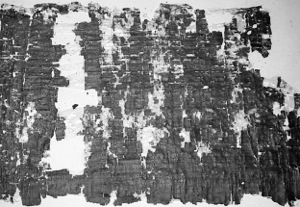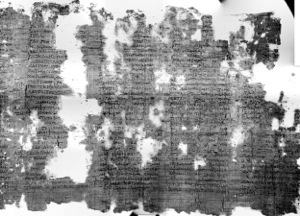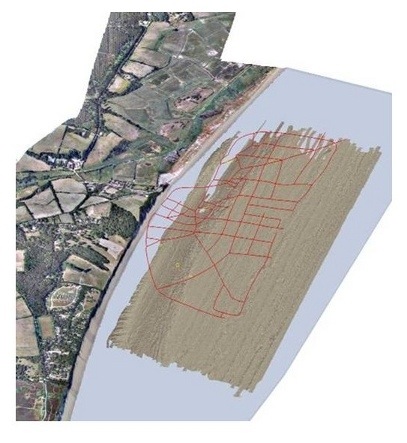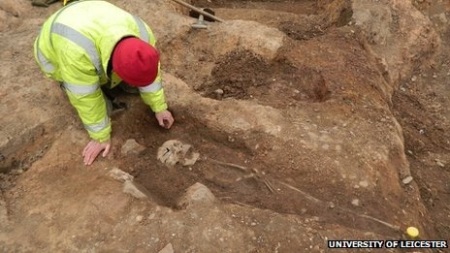Unlocking the scrolls of Herculaneum
Robin Banerji – BBC News Magazine
The British Museum 2013 show of artefacts from the Roman cities of Pompeii and Herculaneum, buried in ash during an explosive eruption of Mount Vesuvius, was a sell-out. But could even greater treasures – including lost works of classical literature – still lie underground?
For centuries scholars have been hunting for the lost works of ancient Greek and Latin literature. In the Renaissance, books were found in monastic libraries. In the late 19th Century papyrus scrolls were found in the sands of Egypt. But only in Herculaneum in southern Italy has an entire library from the ancient Mediterranean been discovered in situ.
On the eve of the catastrophe in 79 AD, Herculaneum was a chic resort town on the Bay of Naples, where many of Rome’s top families went to rest and recuperate during the hot Italian summers. It was also a place where Rome’s richest engaged in a bit of cultural one-upmanship – none more so than Lucius Calpurnius Piso Caesoninus, a politician and father-in-law of Julius Caesar. In Herculaneum, Piso built a seaside villa on a palatial scale – the width of its beach frontage alone exceeds 220m (721ft). When it was excavated in the middle of the 18th Century, it was found to hold more than 80 bronze and marble statues of the highest quality, including one of Pan having sex with a goat.
Piso’s grand villa, which has come to be known as the Villa of the Papyri, also contains the only library to have survived from the classical world. It is a relatively small collection, some 2,000 scrolls, which the eruption nearly destroyed and yet preserved at the same time. A blast of furnace-like gas from the volcano at 400C (752F) carbonised the papyrus scrolls, before the town was buried in a fine volcanic ash which later cooled and solidified into rock.
When excavators and treasure hunters set about exploring the villa in the 18th Century, they mistook the scrolls for lumps of charcoal and burnt logs. Some were used as torches or thrown on to the fire. But once it was realised what they were – possibly because of the umbilicus, the stick at the centre of the scrolls – the challenge was to find a way to open them.
Some scrolls were simply hacked apart with a butcher’s knife – with predictable and lamentable results. Later a conservator from the Vatican, Father Antonio Piaggio (1713-1796), devised a machine to delicately open the scrolls. But it was slow work – the first one took around four years to unroll. And the scrolls tended to go to pieces. The fragments pulled off by Piaggio’s machine were fragile and hard to read. “They are as black as burnt newspaper,” says Dirk Obbink, a lecturer in Papyrology at Oxford University, who has been working on the Herculaneum papyri since 1983.
Under normal light the charred paper looks “a shiny black” says Obbink, while “the ink is a dull black and sort of iridesces”.
Reading it is “not very pleasant”, he adds. In fact, when Obbink first began working on them in the 1980s the difficulty of the fragments was a shock. On some pieces, the eye can make out nothing. On others, by working with microscopes and continually moving the fragments to catch the light in different ways, some few letters can be made out. Meanwhile, the fragments fall apart. “At the end of the day there would be black dust on the table – the black dust of the scroll powdering away. I didn’t even want to breathe.”

A section of On the Good King by Philodemus of Gadara, in normal light…
This all began to change 15 years ago.
In 1999, scientists from Brigham Young University in the US examined the papyrus using infrared light. Deep in the infrared range, at a wavelength of 700-900 nanometres, it was possible to achieve a good contrast between the paper and the ink. Letters began to jump out of the ancient papyrus. Instead of black ink on black paper, it was now possible to see black lines on a pale grey background. Scholars’ ability to reassemble the texts improved massively. “Most of our previous readings were wrong,” says Obbink. “We could not believe our eyes. We were ‘blinded’ by the real readings. The text wasn’t what we thought it was and now it made sense.”
In 2008, a further advance was made through multi-spectral imaging. Instead of taking a single (“monospectral”) image of a fragment of papyrus under infrared light (at typically 800 nanometres) the new technology takes 16 different images of each fragment at different light levels and then creates a composite image. With this technique Obbink is seeking not only to clarify the older infrared images but also to look again fragments that previously defied all attempts to read them. The detail of the new images is so good that the handwriting on the different fragments can be easily compared, which should help reconstruct the lost texts out of the various orphan fragments. “The whole thing needs to be redone,” says Obbink.

…And the same scroll seen in multi-spectral infrared light. There are four columns of text, with many gaps. The first column begins: “…hold power… think… but in both circumstances ‘one wise counsel conquers many hands’, and usually affairs succeed by this means, both without weapons and with a moderate force. This did not escape the poet, but he himself called Nestor ‘bulwark of the Achaeans’ because he was most experienced among them…”
So what has been found? Lost poems by Sappho, the 100-plus lost plays of Sophocles, the lost dialogues of Aristotle? Not quite.
Despite being found in Italy, most of the recovered material is in Greek. Perhaps the major discovery is a third of On Nature, a previously lost work by the philosopher Epicurus. But many of the texts that have emerged so far are written by a follower of Epicurus, the philosopher and poet Philodemus of Gadara (c.110-c.40/35BC). In fact, so many of his works are present, and in duplicate copies, that David Sider, a classics professor at New York University, believes that what has been found so far was in fact Philodemus’s own working library. Piso was Philodemus’s patron.
Not all of the villa’s scrolls have been unrolled though – and because of the damage they suffer in the unwinding process that work has now been halted. Might it be possible to read them by unrolling them not physically, but virtually? In 2009 two unopened scrolls from Herculaneum belonging to the Institut de France in Paris were placed in a Computerised Tomography (CT) scanner, normally used for medical imaging. The machine, which can distinguish different kinds of bodily tissue and produce a detailed image of a human’s internal organs could potentially be used to reveal the internal surfaces of the scroll. The task proved immensely difficult, because the scrolls were so tightly wound, and creased.
“We were able to unwrap a number of sections from the scroll and flatten them into 2D images – and on those sections you can clearly see the structure of the papyrus: fibers, sand,” says Dr Brent Seales, a computer science professor at the University of Kentucky, who led the effort. But the machine could not distinguish “the chemistry of the ink from the chemistry of the paper,” he says. It is unfortunate that ancient ink contains no metal. Seales is continuing to analyse the data produced by the 2009 scan. He has also begun testing a new way of reading the scrolls, using a beam from a particle accelerator. Others are more preoccupied with the idea that there may be more scrolls in the villa waiting to be discovered. Richard Janko, professor of classical studies at the University of Michigan is “pretty certain that there’s more there”.
The villa belonged to Latin-speaking Roman aristocrats, Lucius Calpurnius Piso and his son of the same name – so, Janko reasons, there would have been a Latin library as well as the mostly Greek library already discovered. Secondly, the villa was, he says, not merely a holiday home but a mouseion—a museum-like place to show off a collection of spectacular works of art and literature. If this mouseion had literature to compare to its sculptures, we should expect something more impressive than the working collection of a minor philosopher such as Philodemus. We might even hope for an early edition of the Aeneid, as Virgil and Philodemus knew each other. Thirdly, scrolls were found in various places in the villa. Although some were on shelves and in cabinets, others were piled on the ground and packed in the tubular boxes (capsae) in which scrolls were carried around. Could these boxes have been brought from another part of the building, as yet unknown, where further scrolls remain still?
Robert Fowler, professor of classics at Bristol University, points out that near the room where many of the scrolls were found, and on the same level, is a section of the villa that has never been dug up. The Swiss engineer Karl Weber, who led the dig of the villa in the 1750s “was defeated by the nature of the material in the site next to where the scrolls were found,” he says. And the villa also has three levels. Only the topmost has been substantially explored so far, but in the 1990s two other layers were partially revealed. In the middle floor, archaeologists have discovered a range of well-furnished rooms with views out to sea, some of which have been opened up while others remain closed. Could this be where the villa’s owners kept their good stuff? So far, all we have are guesses. Only digging will provide proof. But Fowler remains hopeful that the villa could yet contain a literary “bonanza”. Someday, he is sure, we shall be able to re-read the ancient scrolls.
The Italian authorities are reluctant to permit further excavation, arguing that this would be disruptive for residents of the modern town of Ercolano, built literally on top of Herculaneum. They also point out that 300-400 of the original rolls remain unread.
In the meantime Fowler tries to keep up the pressure. He reckons that we have perhaps 10% of the great works of classical literature, so any chance to recover the rest is precious. “Just imagine if there were two plays by Shakespeare which we knew of but had never read and which we believed lay underground in a particular place: do you think we would question the decision to dig them up? Do you think we would be hesitating?” And if we did need another reason for speed, there is always the volcano. Mount Vesuvius has erupted a dozen times in the last 200 years, the last major eruption in 1944. As Richard Janko says, another big eruption might end our chance of recovering the ancient literature in Herculaneum for ever.
Source – @BBCNewsMagazine © 2013

